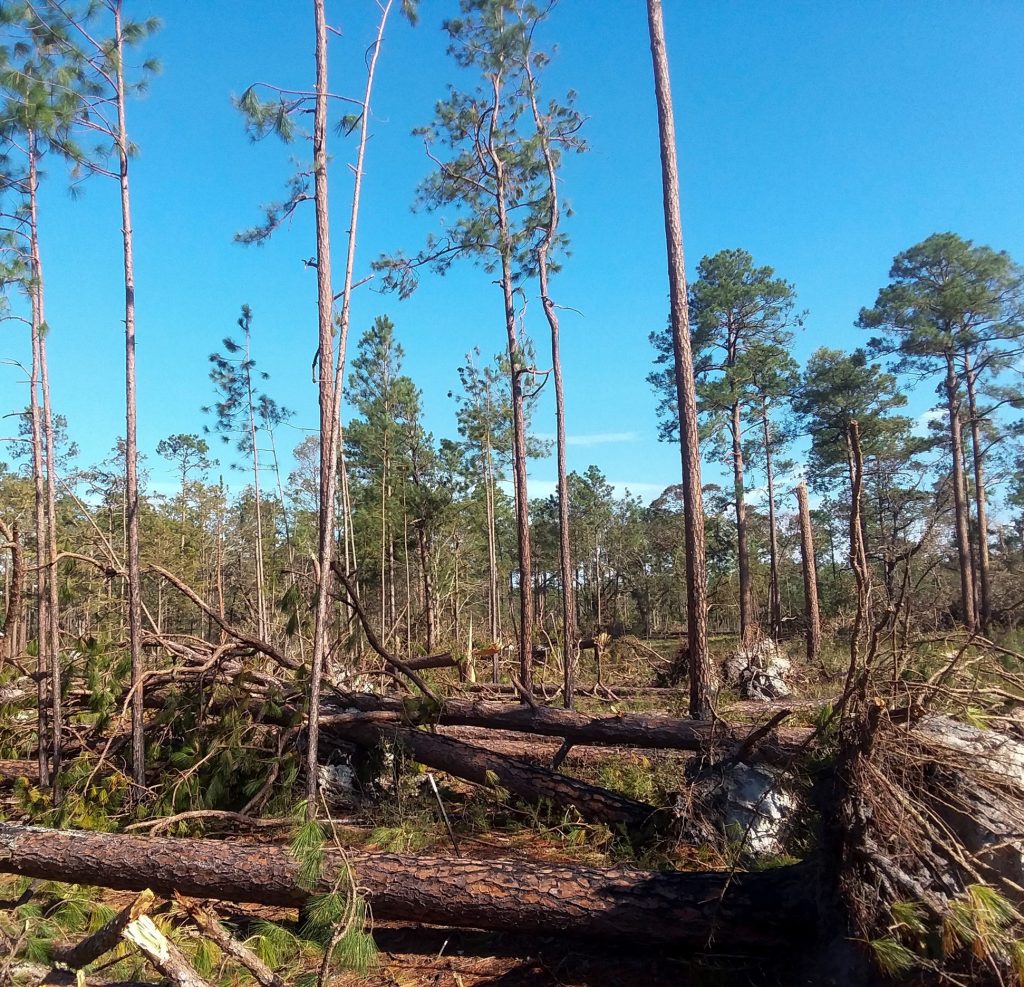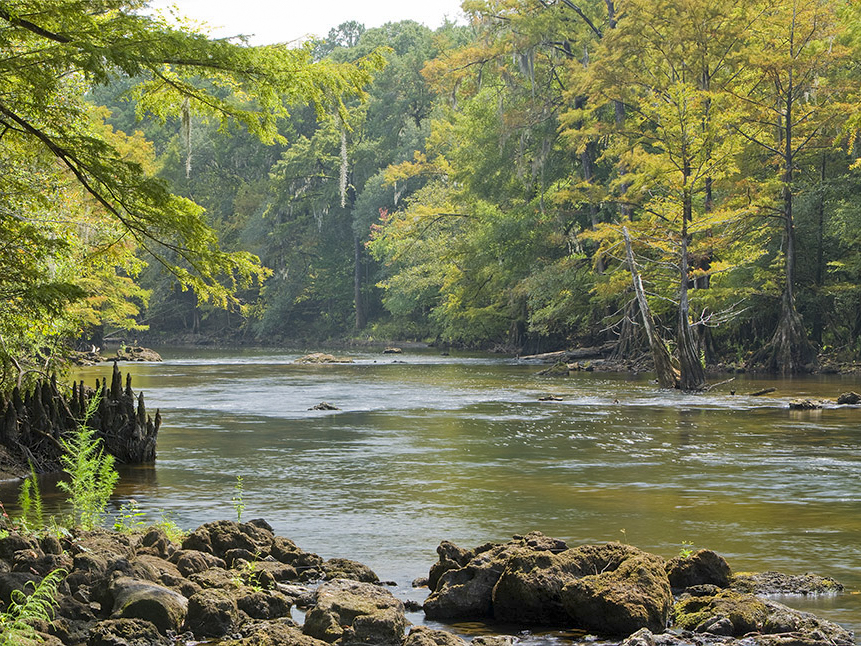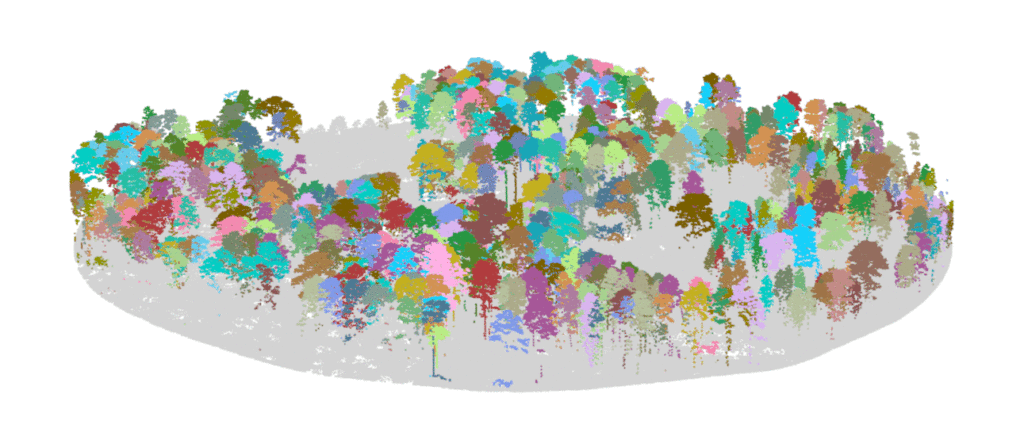Research
The mission of the landscape ecology lab is to inform the conservation and management of ecosystems in the Southeastern US and beyond. This mission forms the basis of our major research goals are to
Hurricane Ecology and Risk

Both major and minor hurricanes can cause substantial losses of timber. But frequent storms are also an integral part of the ecosystem enriching wildlife habitat, regeneration, and even longleaf pine cone production.
Tropical cyclones are a common disturbance that affect many forests globally. Hurricanes in forests represent both a great risk and an important ecological force. Record breaking years in hurricane activity and climate models each point to an increasing impacts of hurricanes in coming decades.
Our lab has developed several research projects focused on quantifying hurricane risk and their role in shaping ecosystems. Our work on hurricane risk spans scales from entire continents, to forest stands, and downt to individual trees. We have used hurricane models to define hurricane regimes that classify risk for all of North America. We conducted widespread post-storm surveys to assess how tree species differ in wind vulnearability. We examined how careful management of forest structure can help mitigate wind damage. And we have used tree winching studies to explore how interactions between roots and soil may vary between species in ways that affect tree stability. Our ongoing and future research on hurricane risk will expand our understanding of hurricane risk at regional scales and incorporate forested agricultural systems such as pecan.
Hurricanes in forests represent both a great risk and an important ecological force
One interesting line of inquiry in our lab is starting to reveal that hurricanes may be integral to the ecology of some forest ecosystems. Together with frequent fire, we are exploring how hurricanes may help maintain the structure and function of longleaf pine systems. We have found that hurricanes can temporarily increase reproduction of longleaf pine, and can create a complex pattern of canopy gaps that influence regeneration. We are currently exploring whether species differences in canopy architecture are consistent with the prediction that hurricanes may drive evolutionary differences in the crown morphology of southern pines. Through integrative collaborations, we are exploring how hurricanes may be important for maintaining heterogenous wildlife habitat. See below for key studies and a bibliography on our lab’s work in hurricane ecology and risk.
Key studies
Cannon, JB, SH Scully, RS Taylor, CJ Peterson, T Newson. (2024) Soil moisture increases stability of North American Pinus species growing in sandy soils. Forest Ecology and Management 565, 122009. [Link]
Cannon, JB, BT Rutledge, JJ Puhlick, JL Willis, DG Brockway (2024). Tropical cyclones stimulate cone production in the masting species longleaf pine (Pinus palustris Mill.). New Phytologist. [Link]
Whelan, AW, SW Bigelow, C Staudhammer, G Starr, JB Cannon (2024). Damage prediction for planted longleaf pine in extreme winds. Forest Ecology and Management 560: 121828. [Link]
Arko, A, JB Cannon, A Himes, A Polinko (2024). The effects of a moderate severity hurricane on gap characteristics in a longleaf pine (Pinus palustris Mill.) woodland. Forest Ecology and Management 551: 121502. [Link]
Cannon, JB, CJ Peterson, C Godfrey, AW Whelan (2023) Hurricane wind regimes for forests of North America. Proceedings of the National Academy of Sciences 120: e2309076120. [Link]
Peterson, CJ and JB Cannon (2021) Modelling wind damage to southeastern U.S. trees: effects of wind profile, gaps, neighborhood interactions, and tree spatial distribution. Frontiers in Forests and Global Change 4:719813. [Link]
Bigelow, SW, CL Looney, JB Cannon (2021). Hurricane effects on climate-adaptive silviculture treatments to longleaf pine woodland in southwestern Georgia, USA. Forestry: An International Journal of Forest Research, cpaa042. [Link]
Cannon, JB, CJ Peterson, JJ O’Brien, JS Brewer (2017). A review and classification of interactions between forest disturbance from wind and fire. Forest Ecology and Management 409: 381–390. [Link]
Improving Restoration Outcomes
From the fire-starved pine forests of the eastern. U.S. to the wildfire-prone forests of the west, pine forests across the U.S. have a growing need for conservation and restoration. The field of landscape ecology provides approaches to address conservation needs at multiple scales.
Restoration of longleaf pine typically means replanting or re-introducing prescribed fire into otherwise degraded forests. In ponderosa pine forests, restoration often means reducing tree density and restoring the structural variability that once characterized these stands.
Our lab engages in research to increase effectiveness of conservation at mnay scales. Restoration operations typically occur at the scale of a few hundred acres, but restoration affects ecological processes at much large scales like hydrology, wildlife habitat, or wildfire risk. Landscape-scale approaches can help prioritize restoration efforts that will have the greatest impact on large-scale procceses. Our lab contributse to interdisciplinary research that has found that restoration of longleaf pine can enhance water supply in streams, especially during drought. Careful selection of restoration sites for ponderosa pine can enhance bird habitat, decrease wildfire risk.
Landscape ecology provides approaches to address conservation needs at multiple scales
New and exciting work in our lab addresses questions around environmental justice in longleaf pine. Frequent burning is necessary to maintain the biodiversity in longleaf pine, but smoke from wildland fires disproportionately impacts those in rural communites, especially African Americans. In a collaboration with the Engineering Environmental Equity (E3) Lab at the University of Georgia, we are addressing how improvements to regional burn planning may mitigate these environmental discrepancies.
Restoration of longleaf pine forests also depends on restoring the frequent fire regimes that historically characterized the ecosystem. Fire behavior and its effects depend on complex feedbacks between fire and vegetation. Landscape ecology provides many spatial tools for unraveling the complex feedbacks between vegetation and fire. Recently, we have established the Ichauway Forest Dynamics Plot a 40 acre (15 ha) mapped plot with >18,000 mapped trees. The plot is part of the Smithsonian ForestGEO network and will provide an unprecedented infrastructure for studying feedbacks between vegetation and fire at fine scales.
Our lab is addressing many fundamental questions about vegetation fire feedbacks at fine scales. We have generated spatial models for predicting how fuel input from leaf litter varies spatially. We have also uncovered that leaf litter drying properties differ widely based on species and overstory properties. We have also explored how silvicultural interventions in longleaf pine influence growth and mortality and ultimately influence spatial structure.

Forest restoration can influence other ecological proccess at much larger scales including water supply, wildlife habitat, and wildfire risk. Our lab combines large-scale datasets and modeling to assess and priortize restoration efforts to acheive landscape-scale benefits and goals

The Ichauway Forest Dynamics Plot is a 40 acre research infrastructure to study fire-vegetation feedbacks in longleaf pine at fine scales. The plot is part of the Smithsonian ForestGEO network of similar plots spanning 76 ecosystems across the globe.
Key studies
English, CJ, SE Younger, JB Cannon, ST Brantley, D Markewitz P Dwivedi (2024). Longleaf Pine Restoration for Water Yield: Economic Analysis with Federal Cost-share Programs. Trees, Forests, and People 17: 100600 [Link]
Gonçalves Lazzaro, L, JB Cannon, MJ Aspinwell, HD Alexander (2024). Overstory and fuel traits drive moisture dynamics of mesophytic and pyrophytic leaf litter and 10-hour woody debris fuels in a mixed longleaf pine-hardwood woodland. Fire Ecology 20: 63. [Link]
Willis, JL, DC Bragg, JB Cannon, KJK Gandhi, KR Kidd, AD Polinko, JJ Puhlick, D Saenz, MA Sayer, CM Schalk, AB Self, CM Siegert, JM Varner (2024). Assessing the potential impact of retaining native off-site tree species in woodland restoration? Restoration Ecology 32: e14119 [Link]
Hill, EM, MD Redmond, JB Cannon, S Ex, TW Ocheltree (2024). Canopy-mediated microclimate refugia do not match narrow regeneration niches in a managed dry conifer forest. Forest Ecology and Management 553: 121566. [Link]
Younger, S, JB Cannon, ST Brantley (2023). Impacts of longleaf pine (Pinus palustris Mill.) on long-term hydrology at the watershed scale. Science of the Total Environment 902: 165999 [Link]
Blaydes, SH, JB Cannon, DP Aubrey (2023). Modeling needle fuel dispersal in longleaf pine-dominated forests. Fire Ecology 19: 56 [Link]
Cannon, JB, SW Bigelow, JK Hiers, SB Jack (2022) Effects of silvicultural selection treatments on spatial pattern and dynamics in a Pinus palustris Mill. woodland. Forest Ecology and Management 505:119888. [Link]
Latif, QS, JB Cannon EJ Chabot, RA Sparks, (2022). Simulated treatment effects on bird species occupancy and richness inform landscape-scale dry conifer forest management. Ecological Applications 32:e2555 [Link]
Applying new technologies for conservation

New technologies such as aerial lidar, and algorithms for mapping and measuring individual trees allow researchers to extract unprecedented detail about forests at very large scales. Our work uses aerial and terrestrial lidar as well as satelittes and drones to offer new perpsectives for addressing environmental challenges.

Forest conservation in the 21st century faces unprecedented challenges due to climate change, deforestation, habitat fragmentation, and biodiversity loss. However, emerging technologies offer promise for addressing environmental challenges at a grand scale. Remote sensing technologies such as satellite imagery, aerial and terrestrial lidar, and UAV imaging are becoming ubiquitous and accessible. At the same time, machine learning techniques, and cloud computer platforms are becoming widely accessible allowing researchers to finely calibrate remote sensing measurements to their real-world meaning. Open source electronics and sensors allow low-cost options for fine-scale measurements with many applications in ecology.
Emerging technologies offer promise for addressing environmental challenges at a grand scale
Our lab works closely with partners to advance the application and adoption of new technologies to address issues important to conservation. Our lab has applied new algorithms for processing airborne-lidar that improve measurement efficiency in longleaf pine forests. We have also developed and low-cost and open source sensor networks for measuring fine-scale environmental variation useful in fire ecology, forest ecology, and urban forests. In one new effort, we are working with a game design firm to develop a virtual reality software to train forest managers in complex individual tree selection methods.
In addition to research applications, we also contribute to education efforts to increase remote sensing capacity among natural resource professionals. Recently, we have developed an online module that serves as a broad introduction to using aerial lidar for natural resources. We have also released a remote pilot study guide to assist those interested in a receiving a Part 107 Remote Pilot certificate, which is required for many research applications of UAVs. Future work will emphasize expanding these trainings to reach a broader public audience of professionals.
Key studies and resources
JB Cannon (2024) Remote Pilot Certification study guide for natural resource professionals. Online resource [Link]
Arko, A, JB Cannon, A Himes, A Polinko (2024). The effects of a moderate severity hurricane on gap characteristics in a longleaf pine (Pinus palustris Mill.) woodland. Forest Ecology and Management 551: 121502. [Link]
Whelan, AW, JB Cannon, SW Bigelow, BT Rutledge, AJ Sánchez Meador (2023). Improving generalized models of forest structure in complex forest types using area- and voxel-based approaches from lidar. Remote Sensing of Environment 284: 113362. [Link]
Cannon, JB, LT Warren, GC Ohlson, JK Hiers, M Shrestha, C Mitra, EM Hill, SJ Bradfield, TW Ocheltree (2022). Applications of low-cost environmental monitoring systems for fine-scale abiotic measurements in forest ecology. Agricultural and Forest Meteorology 321:108973. [Link]
